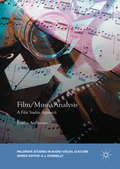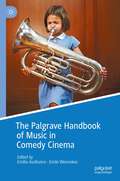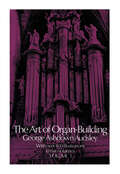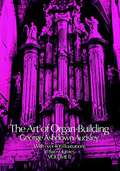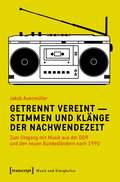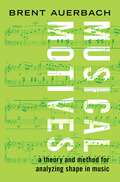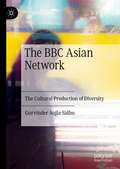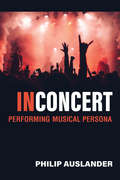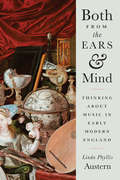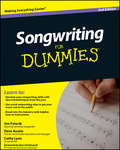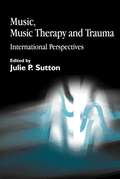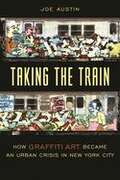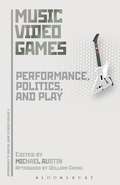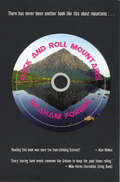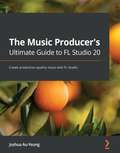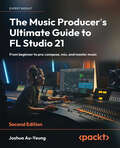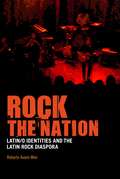- Table View
- List View
Film/Music Analysis: A Film Studies Approach
by Emilio AudissinoThis book offers an approach to film music in which music and visuals are seen as equal players in the game. The field of Film-Music Studies has been increasingly dominated by musicologists and this book brings the discipline back squarely into the domain of Film Studies. Blending Neoformalism with Gestalt Psychology and Leonard B. Meyer's musicology, this study treats music as a cinematic element and offers scholars and students of both music and film a set of tools to help them analyse the wide ranging impact that music has in films.
Film/Music Analysis: A Film Studies Approach
by Emilio AudissinoThis book offers an approach to film music in which music and visuals are seen as equal players in the game. The field of Film-Music Studies has been increasingly dominated by musicologists and this book brings the discipline back squarely into the domain of Film Studies. Blending Neoformalism with Gestalt Psychology and Leonard B. Meyer's musicology, this study treats music as a cinematic element and offers scholars and students of both music and film a set of tools to help them analyse the wide ranging impact that music has in films.
The Palgrave Handbook of Music in Comedy Cinema
by Emilio Audissino Emile WennekesThis handbook tackles the understudied relationship between music and comedy cinema by analysing the nature, perception, and function of music from fresh perspectives. Its approach is not only multidisciplinary, but also interdisciplinary in its close examination of how music and other cinematic devices interact in the creation of comedy. The volume addresses gender representation, national identities, stylistic strategies, and employs inputs from cultural studies, musicology, music theory, psychology, cognitivism, semiotics, formal and stylistic film analysis, and psychoanalysis. It is organised in four sections: general introductions, theoretical investigations, music and comedy within national cinemas, and exemplary case studies of films or authors.
The Art of Organ Building
by George Ashdown AudsleyVolume 1 of the fullest repository on organ building and history in English language. Includes outline of organ history, external design and decoration, internal arrangement and mechanical systems, acoustics and theories of sound-production in organ pipes, tonal structure and appointment, compound stops of the organ, more. Complete with illustrations, tables, and specifications. "the most significant republication in our field for the past twenty years . . . an incomparable, invaluable book." -- American Guild of Organists Quarterly.
The Art of Organ Building (Dover Books on Music #2)
by George Ashdown AudsleyVolume 2 of the fullest repository on organ building and history in English language. Includes outline of organ history, external design and decoration, internal arrangement and mechanical systems, acoustics and theories of sound-production in organ pipes, tonal structure and appointment, compound stops of the organ, more. Complete with illustrations, tables, and specifications. "...the most significant republication in our field for the past twenty years...an incomparable, invaluable book." — American Guild of Organists Quarterly.
Getrennt vereint - Stimmen und Klänge der Nachwendezeit: Zum Umgang mit Musik aus der DDR und den neuen Bundesländern nach 1990 (Musik und Klangkultur #50)
by Jakob AuenmüllerIn der musikwissenschaftlichen Forschung spielt die Auseinandersetzung mit der Nachwendezeit eine sehr marginale Rolle. Dies gilt vor allem auch für die Frage nach dem Umgang mit Musik aus der DDR und den neuen Bundesländern seit 1990. Jakob Auenmüller stellt hierzu in mehreren empirischen Teilstudien Grundlagen und Angebote für Forschung und Praxis zur Disposition - und liefert ein Plädoyer für die verstärkte Hinwendung der Musikforschung zur Aufarbeitung der Nachwendezeit. Dabei wird deutlich, inwiefern das Musikleben in Zukunft noch stärker als aktive Plattform für Aushandlungsprozesse eines nachhaltigen gesamtdeutschen Zusammenwachsens fungieren kann und sollte.
Musical Motives: A Theory and Method for Analyzing Shape in Music
by Brent AuerbachAll music fans harbor in their memories vivid fragments of their favorite works. The starting guitar solo of "Satisfaction" by the Rolling Stones, the da-da-da-DUM gesture that opens Beethoven's Fifth Symphony, the lush swelling chords of a beloved movie soundtrack: hearing the briefest snippet of any of these is enough to transport listeners into the piece's sonic and emotional world. But what makes musical motives so powerful? In Musical Motives, author Brent Auerbach looks at the ways that motives the small-scale pitch and rhythm shapes that are ever-present in music unify musical compositions and shape our experiences of them. Motives serve both to communicate basic musical meaning and to tie together sound space like the motifs in visual art. They present in all genres from classical and popular to jazz and world music, making them ideally suited for analysis. Musical Motives opens with a general introduction to these fundamental building blocks, then lays out a comprehensive theory and method to account for music's structure and drama in motivic terms. Aimed at both amateur and expert audiences, the book offers a tiered approach that progresses from Basic to Complex Motivic Analysis. The methods are illustrated by small- and large-scale analyses of pieces by Mozart, Beethoven, Handel, Chaminade, Verdi, Radiohead, and many more.
Musical Motives: A Theory and Method for Analyzing Shape in Music
by Brent AuerbachAll music fans harbor in their memories vivid fragments of their favorite works. The starting guitar solo of "Satisfaction" by the Rolling Stones, the da-da-da-DUM gesture that opens Beethoven's Fifth Symphony, the lush swelling chords of a beloved movie soundtrack: hearing the briefest snippet of any of these is enough to transport listeners into the piece's sonic and emotional world. But what makes musical motives so powerful? In Musical Motives, author Brent Auerbach looks at the ways that motives the small-scale pitch and rhythm shapes that are ever-present in music unify musical compositions and shape our experiences of them. Motives serve both to communicate basic musical meaning and to tie together sound space like the motifs in visual art. They present in all genres from classical and popular to jazz and world music, making them ideally suited for analysis. Musical Motives opens with a general introduction to these fundamental building blocks, then lays out a comprehensive theory and method to account for music's structure and drama in motivic terms. Aimed at both amateur and expert audiences, the book offers a tiered approach that progresses from Basic to Complex Motivic Analysis. The methods are illustrated by small- and large-scale analyses of pieces by Mozart, Beethoven, Handel, Chaminade, Verdi, Radiohead, and many more.
The BBC Asian Network: The Cultural Production of Diversity
by Gurvinder Aujla-SidhuThis ground-breaking new book provides a unique, in-depth analysis of the BBC Asian Network, the BBC’s national ethnic-specific digital radio station in the UK. Gurvinder Aujla-Sidhu offers an insight into the internal production culture at the radio station, revealing the challenges minority ethnic producers faced as they struggled to create a cohesive and distinct 'community of listeners'. Besides the differences of opinion that emerged within the inter-generational British Asian staff over how to address the audience’s needs, the book also reveals the ways in which 'race' is managed by the BBC, and how the culture of managerialism permeates recruitment strategies, music playlists and mother tongue language programmes. In-depth interviews unveil how the BBC's 'gatekeeping' system limits the dissemination of original journalism about British Asian communities, through the marginalisation of the expertise of narratives created by the network's own minority ethnic journalists.
In Concert: Performing Musical Persona
by Philip AuslanderThe conventional way of understanding what musicians do as performers is to treat them as producers of sound; some even argue that it is unnecessary to see musicians in performance as long as one can hear them. But musical performance, counters Philip Auslander, is also a social interaction between musicians and their audiences, appealing as much to the eye as to the ear. In Concert: Performing Musical Persona he addresses not only the visual means by which musicians engage their audiences through costume and physical gesture, but also spectacular aspects of performance such as light shows. Although musicians do not usually enact fictional characters on stage, they nevertheless present themselves to audiences in ways specific to the performance situation. Auslander’s term to denote the musician’s presence before the audience is musical persona. While presence of a musical persona may be most obvious within rock and pop music, the book’s analysis extends to classical music, jazz, blues, country, electronic music, laptop performance, and music made with experimental digital interfaces. The eclectic group of performers discussed include the Beatles, Miles Davis, Keith Urban, Lady Gaga, Nicki Minaj, Frank Zappa, B. B. King, Jefferson Airplane, Virgil Fox, Keith Jarrett, Glenn Gould, and Laurie Anderson.
Both from the Ears and Mind: Thinking about Music in Early Modern England
by Linda Phyllis AusternBoth from the Ears and Mind offers a bold new understanding of the intellectual and cultural position of music in Tudor and Stuart England. Linda Phyllis Austern brings to life the kinds of educated writings and debates that surrounded musical performance, and the remarkable ways in which English people understood music to inform other endeavors, from astrology and self-care to divinity and poetics. Music was considered both art and science, and discussions of music and musical terminology provided points of contact between otherwise discrete fields of human learning. This book demonstrates how knowledge of music permitted individuals to both reveal and conceal membership in specific social, intellectual, and ideological communities. Attending to materials that go beyond music’s conventional limits, these chapters probe the role of music in commonplace books, health-maintenance and marriage manuals, rhetorical and theological treatises, and mathematical dictionaries. Ultimately, Austern illustrates how music was an indispensable frame of reference that became central to the fabric of life during a time of tremendous intellectual, social, and technological change.
Both from the Ears and Mind: Thinking about Music in Early Modern England
by Linda Phyllis AusternBoth from the Ears and Mind offers a bold new understanding of the intellectual and cultural position of music in Tudor and Stuart England. Linda Phyllis Austern brings to life the kinds of educated writings and debates that surrounded musical performance, and the remarkable ways in which English people understood music to inform other endeavors, from astrology and self-care to divinity and poetics. Music was considered both art and science, and discussions of music and musical terminology provided points of contact between otherwise discrete fields of human learning. This book demonstrates how knowledge of music permitted individuals to both reveal and conceal membership in specific social, intellectual, and ideological communities. Attending to materials that go beyond music’s conventional limits, these chapters probe the role of music in commonplace books, health-maintenance and marriage manuals, rhetorical and theological treatises, and mathematical dictionaries. Ultimately, Austern illustrates how music was an indispensable frame of reference that became central to the fabric of life during a time of tremendous intellectual, social, and technological change.
Both from the Ears and Mind: Thinking about Music in Early Modern England
by Linda Phyllis AusternBoth from the Ears and Mind offers a bold new understanding of the intellectual and cultural position of music in Tudor and Stuart England. Linda Phyllis Austern brings to life the kinds of educated writings and debates that surrounded musical performance, and the remarkable ways in which English people understood music to inform other endeavors, from astrology and self-care to divinity and poetics. Music was considered both art and science, and discussions of music and musical terminology provided points of contact between otherwise discrete fields of human learning. This book demonstrates how knowledge of music permitted individuals to both reveal and conceal membership in specific social, intellectual, and ideological communities. Attending to materials that go beyond music’s conventional limits, these chapters probe the role of music in commonplace books, health-maintenance and marriage manuals, rhetorical and theological treatises, and mathematical dictionaries. Ultimately, Austern illustrates how music was an indispensable frame of reference that became central to the fabric of life during a time of tremendous intellectual, social, and technological change.
Both from the Ears and Mind: Thinking about Music in Early Modern England
by Linda Phyllis AusternBoth from the Ears and Mind offers a bold new understanding of the intellectual and cultural position of music in Tudor and Stuart England. Linda Phyllis Austern brings to life the kinds of educated writings and debates that surrounded musical performance, and the remarkable ways in which English people understood music to inform other endeavors, from astrology and self-care to divinity and poetics. Music was considered both art and science, and discussions of music and musical terminology provided points of contact between otherwise discrete fields of human learning. This book demonstrates how knowledge of music permitted individuals to both reveal and conceal membership in specific social, intellectual, and ideological communities. Attending to materials that go beyond music’s conventional limits, these chapters probe the role of music in commonplace books, health-maintenance and marriage manuals, rhetorical and theological treatises, and mathematical dictionaries. Ultimately, Austern illustrates how music was an indispensable frame of reference that became central to the fabric of life during a time of tremendous intellectual, social, and technological change.
Songwriting For Dummies (For Dummies)
by Dave Austin Jim Peterik Cathy Lynn AustinProven techniques for songwriting success This friendly, hands-on guide tackles the new face of the recording industry, guiding you through the shift from traditional sales to downloads and mobile music, as well as how you can harness social media networks to get your music "out there." You get basic songwriting concepts, insider tips and advice, and inspiration for writing — and selling — meaningful, timeless songs. Songwriting 101 — get a grip on everything you need to know to write a song, from learning to listen to your "inner voice" to creating a "mood" and everything in between Jaunt around the genres — discover the variety of musical genres and find your fit, whether it's rock, pop, R&B, gospel, country, or more Let the lyrics out — master the art of writing lyrics, from finding your own voice to penning the actual words to using hooks, verses, choruses, and bridges Make beautiful music — find your rhythm, make melodies, and use chords to put the finishing touches on your song Work the Web — harness online marketing and social networks like Facebook, Twitter, and others to get your music heard by a whole new audience Open the book and find: What you need to know before you write a single note Tips on finding inspiration Ways to use poetic devices in lyrics Computer and Web-based shortcuts and technologies to streamline songwriting A look at famous songwriting collaborators Writing for stage, screen, and television How to make a demo to get your song heard Advice on how to make money from your music Learn to: Develop your songwriting skills with tips and techniques from the pros Use social networking sites to get your music out to the public Break into the industry with helpful, how-to instructions
Songwriting For Dummies
by Dave Austin Jim Peterik Cathy Lynn AustinProven techniques for songwriting success This friendly, hands-on guide tackles the new face of the recording industry, guiding you through the shift from traditional sales to downloads and mobile music, as well as how you can harness social media networks to get your music "out there." You get basic songwriting concepts, insider tips and advice, and inspiration for writing — and selling — meaningful, timeless songs. Songwriting 101 — get a grip on everything you need to know to write a song, from learning to listen to your "inner voice" to creating a "mood" and everything in between Jaunt around the genres — discover the variety of musical genres and find your fit, whether it's rock, pop, R&B, gospel, country, or more Let the lyrics out — master the art of writing lyrics, from finding your own voice to penning the actual words to using hooks, verses, choruses, and bridges Make beautiful music — find your rhythm, make melodies, and use chords to put the finishing touches on your song Work the Web — harness online marketing and social networks like Facebook, Twitter, and others to get your music heard by a whole new audience Open the book and find: What you need to know before you write a single note Tips on finding inspiration Ways to use poetic devices in lyrics Computer and Web-based shortcuts and technologies to streamline songwriting A look at famous songwriting collaborators Writing for stage, screen, and television How to make a demo to get your song heard Advice on how to make money from your music Learn to: Develop your songwriting skills with tips and techniques from the pros Use social networking sites to get your music out to the public Break into the industry with helpful, how-to instructions
Music, Music Therapy and Trauma: International Perspectives
by Diane Snow Austin Julie SuttonMusic communicates where words fail, and music therapy has been proven to connect with those who were thought to be unreachable, making it an ideal medium for working with those who have suffered psychological trauma. Music, Music Therapy and Trauma addresses the need for an exploration of current thinking on music and trauma. With chapters written by many of today's leading specialists in this area, music and trauma is approached from a wide range of perspectives, with contributions on the following: * neurology of trauma and music; * music and trauma in general; * social and cultural perspectives on trauma; * contextualising contemporary classical music and conflict; * music and trauma in areas where there is war, community unrest and violence (Northern Ireland, Bosnia-Herzegovina, South Africa); * music, trauma and early development. Including specific examples and case studies, this book addresses the growing interest in the effects of trauma and how music therapy can provide a way through this complex process.
Music, Music Therapy and Trauma: International Perspectives (PDF)
by Diane Snow Austin Julie SuttonMusic communicates where words fail, and music therapy has been proven to connect with those who were thought to be unreachable, making it an ideal medium for working with those who have suffered psychological trauma. Music, Music Therapy and Trauma addresses the need for an exploration of current thinking on music and trauma. With chapters written by many of today's leading specialists in this area, music and trauma is approached from a wide range of perspectives, with contributions on the following: * neurology of trauma and music; * music and trauma in general; * social and cultural perspectives on trauma; * contextualising contemporary classical music and conflict; * music and trauma in areas where there is war, community unrest and violence (Northern Ireland, Bosnia-Herzegovina, South Africa); * music, trauma and early development. Including specific examples and case studies, this book addresses the growing interest in the effects of trauma and how music therapy can provide a way through this complex process.
Taking The Train: How Graffiti Art Became An Urban Crisis In New York City (Popular Cultures, Everyday Lives Ser.)
by Joe AustinIn the 1960s and early 1970s, young people in New York City radically altered the tradition of writing their initials on neighborhood walls. Influenced by the widespread use of famous names on billboards, in neon, in magazines, newspapers, and typographies from advertising and comics, city youth created a new form of expression built around elaborately designed names and initials displayed on public walls, vehicles, and subways. Critics called it "graffiti," but to the practitioners it was "writing." Taking the Traintraces the history of "writing" in New York City against the backdrop of the struggle that developed between the city and the writers. Austin tracks the ways in which "writing" -- a small, seemingly insignificant act of youthful rebellion -- assumed crisis-level importance inside the bureaucracy and the public relations of New York City mayoral administrations and the Metropolitan Transportation Authority for almost two decades. Taking the Trainreveals why a global city short on funds made "wiping out graffiti" an expensive priority while other needs went unfunded. Although the city eventually took back the trains, Austin eloquently shows how and why the culture of "writing" survived to become an international art movement and a vital part of hip-hop culture.
Music Video Games: Performance, Politics, and Play (Approaches to Digital Game Studies)
by Michael AustinMusic Video Games takes a look (and listen) at the popular genre of music games – video games in which music is at the forefront of player interaction and gameplay. With chapters on a wide variety of music games, ranging from well-known console games such as Guitar Hero and Rock Band to new, emerging games for smartphones and tablets, scholars from diverse disciplines and backgrounds discuss the history, development, and cultural impact of music games. Each chapter investigates important themes surrounding the ways in which we play music and play with music in video games. Starting with the precursors to music games - including Simon, the hand-held electronic music game from the 1980s, Michael Austin's collection goes on to discuss issues in musicianship and performance, authenticity and “selling out,” and composing, creating, and learning music with video games. Including a glossary and detailed indices, Austin and his team shine a much needed light on the often overlooked subject of music video games.
Music Video Games: Performance, Politics, and Play (Approaches to Digital Game Studies)
by Michael AustinMusic Video Games takes a look (and listen) at the popular genre of music games – video games in which music is at the forefront of player interaction and gameplay. With chapters on a wide variety of music games, ranging from well-known console games such as Guitar Hero and Rock Band to new, emerging games for smartphones and tablets, scholars from diverse disciplines and backgrounds discuss the history, development, and cultural impact of music games. Each chapter investigates important themes surrounding the ways in which we play music and play with music in video games. Starting with the precursors to music games - including Simon, the hand-held electronic music game from the 1980s, Michael Austin's collection goes on to discuss issues in musicianship and performance, authenticity and “selling out,” and composing, creating, and learning music with video games. Including a glossary and detailed indices, Austin and his team shine a much needed light on the often overlooked subject of music video games.
Rock and Roll Mountains
by Graham Forbes AuthorGraham Forbes loved to play guitar, whether it was with local rock groups pillaging village halls or on the big stages of the world with the Incredible String Band. But, like so many others, he enjoyed the gigs, groupies and booze too much. At 27, he found himself back in Glasgow, ears ringing, scratching his head, completely unemployable, with an empty bottle of tequila in one hand and a huge tax demand in the other. It had been great while it lasted but the party was over.Realising his mind was like and out-of-control firework display and that his next stop was the Happy Duck Rest Home for the Bewildered, Graham noticed there were hills nearby and decided to go for a walk. Just as it seemed he might at last settle down to some sort of normal life he met a crazy climber with a taste for the bizarre . . . It was the beginning of a journey that would transform Graham completely, taking him from poverty to bluffing his way onto the board of directors of a national company, hoping that their next meeting wouldn't be in a hotel he'd wrecked in his previous life. Roaring along with bawdy tales of marauding bands, mad mountaineers and unforgettable Glasgow street characters, Rock and Roll Mountains weaves through wild rock tours and terrifying ice climbing to glowing sunsets on some of the most beautiful summits in the world. It is a book about extreme sport, fear and survival - but without the the gung-ho heroics of mountaineering writers.At times deeply moving, insightful yet hilarious and with an extraordinary climax, this book is for anyone who has looked in the mirror and wondered where it all went wrong . . . Above all, it is very, very funny.
The Music Producer's Ultimate Guide to FL Studio 20: Create production-quality music with FL Studio
by Joshua Au-YeungLeverage the power of FL Studio 20 to create and compose production-quality songs and develop professional music production skillKey FeaturesLeverage the power of FL Studio to create your own production-level musicDevelop widely applicable music production skills and learn how to promote your musicUtilize cutting-edge tools to fuel your creative ideas and publish your songsBook DescriptionFL Studio is a cutting-edge software music production environment. It's an extremely powerful and easy to use tool for creating music. This book will give you everything you need to produce music with FL Studio at a professional level. You'll begin by exploring FL studio 20's vast array of tools and discover best practices, tips, and tricks for creating music. You'll learn how to set up your studio environment, create a beat, compose a melody and chord progression, mix sounds with effects, and export songs. You'll learn how to use tools such as the Piano roll, mixer console, audio envelopes, types of compression, equalizers, vocoders, vocal chops, and tools for increasing stereo width. The book introduces you to mixing best practices and how to master your songs. Along the way, you'll explore glitch effects and create your own instruments and custom designed effect chains. We'll also cover ZGameEditor Visualizer, a tool for creating reactive visuals for your songs. Finally, you'll learn how to register, sell, and promote your music. By the end of this FL Studio book, you'll be able to utilize cutting-edge tools to fuel your creative ideas, mix music effectively, and publish your songs.What you will learnGet up and running with FL Studio 20Record live instruments and vocals and process themCompose melodies and chord progressions on the Piano rollDiscover mixing techniques and apply effects to your tracksExplore best practices to produce music like a professionalPublish songs in online stores and promote your music effectivelyWho this book is forThis book is for music producers, composers, songwriters, DJs, and audio engineers interested in creating their own music, improving music production skills, mixing and mastering music, and selling songs online. To get started with this book, all you need is a computer and FL Studio.
The Music Producer's Ultimate Guide To Fl Studio 21: From Beginner To Pro: Compose, Mix, And Master Music
by Joshua Au-YeungRock the Nation: Latin/o Identities and the Latin Rock Diaspora
by Roberto Avant-MierRock the Nation analyzes Latino/a identity through rock 'n' roll music and its deep Latin/o history. By linking rock music to Latinos and to music from Latin America, the author argues that Latin/o music, people, and culture have been central to the development of rock music as a major popular music form, in spite of North American racial logic that marginalizes Latino/as as outsiders, foreigners, and always exotic. According to the author, the Latin/o Rock Diaspora illuminates complex identity issues and interesting paradoxes with regard to identity politics, such as nationalism. Latino/as use rock music for assimilation to mainstream North American culture, while in Latin America, rock music in Spanish is used to resist English and the hegemony of U.S. culture. Meanwhile, singing in English and adopting U.S. popular culture allows youth to resist the hegemonic nationalisms of their own countries. Thus, throughout the Americas, Latino/as utilize rock music for assimilation to mainstream national culture(s), for resistance to the hegemony of dominant culture(s), and for mediating the negotiation of Latino/a identities.
